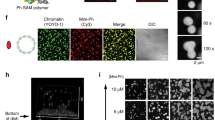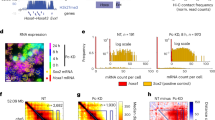Abstract
The polycomb group (PcG) proteins are important in the maintenance of stable repression patterns during development. Several PcG members contain a protein–protein interaction module called a SAM domain (also known as SPM, PNT and HLH). Here we report the high-resolution structure of the SAM domain of polyhomeotic (Ph). Ph-SAM forms a helical polymer structure, providing a likely mechanism for the extension of PcG complexes. The structure of the polymer resembles that formed by the SAM domain of another transcriptional repressor, TEL. The formation of these polymer structures by SAM domains in two divergent repressors suggests a conserved mode of repression involving a higher order chromatin structure.
This is a preview of subscription content, access via your institution
Access options
Subscribe to this journal
Receive 12 print issues and online access
$189.00 per year
only $15.75 per issue
Buy this article
- Purchase on Springer Link
- Instant access to full article PDF
Prices may be subject to local taxes which are calculated during checkout




Similar content being viewed by others
Accession codes
References
Francis, N.J. & Kingston, R.E. Nature Rev. Mol. Cell. Biol. 2, 409–421 (2001).
Pirrotta, V. Cell 93, 333–336 (1998).
Carroll, M., Tomasson, M.H., Barker, G.F., Golub, T.R. & Gilliland, D.G. Proc. Natl. Acad. Sci. USA 93, 14845–14850 (1996).
Tu, H., Barr, M., Dong, D.L. & Wigler, M. Mol. Cell. Biol. 17, 5876–5887 (1997).
Potter, M.D., Buijs, A., Kreider, B., van Rompaey, L. & Grosveld, G.C. Blood 95, 3341–3348 (2000).
Serrapages, C. et al. EMBO J. 14, 2827–2838 (1995).
Kasten, M. & Giordano, A. Oncogene 20, 1832–1838 (2001).
Zhang, H. et al. Proc. Natl. Acad. Sci. USA 97, 2597–2602 (2000).
Seidel, J.J. & Graves, B.J. Genes Dev. 16, 127–137 (2002).
Wang, W.K. et al. Acta Crystallogr. D 57, 545–551 (2001).
Thanos, C.D. et al. J. Biol. Chem. 274, 37301–37306 (1999).
Thanos, C.D., Goodwill, K.E. & Bowie, J.U. Science 283, 833–836 (1999).
Smalla, M. et al. Protein Sci. 8, 1954–1961 (1999).
Chi, S.W., Ayed, A. & Arrowsmith, C.H. EMBO J. 18, 4438–4445 (1999).
Stapleton, D., Balan, I., Pawson, T. & Sicheri, F. Nature Struct. Biol. 6, 44–49 (1999).
Slupsky, C.M. et al. Proc. Natl. Acad. Sci. USA 95, 12129–12134 (1998).
Kim, C.A. et al. EMBO J. 20, 4173–4182 (2001).
Peterson, A.J. et al. Mol. Cell. Biol. 17, 6683–6692 (1997).
Kyba, M. & Brock, H.W. Dev. Genet. 22, 74–84 (1998).
Gunster, M.J. et al. Mol. Cell. Biol. 17, 2326–2335 (1997).
Fitzgerald, D.P. & Bender, W. Mol. Cell. Biol. 21, 6585–6597 (2001).
Shao, Z.H. et al. Cell 98, 37–46 (1999).
Boivin, A. & Dura, J.M. Genetics 150, 1539–1549 (1998).
Muller, J. EMBO J. 14, 1209–1220 (1995).
Van Duyne, G.D., Standaert, R.F., Karplus, P.A., Schreiber, S.L. & Clardy, J. J. Mol. Biol. 229, 105–124 (1993).
Otwinowski, Z. & Minor, W. Methods Enzymol. 276, 307–326 (1997).
Terwilliger, T.C. & Berendzen, J. Acta Crystallogr. D 55, 849–861 (1999).
Collaborative Computational Project, Number 4. Acta Crystallogr. D 50, 760–763 (1994).
Perrakis, A., Morris, R. & Lamzin, V.S. Nature Struct. Biol. 6, 458–463 (1999).
Brünger, A.T. et al. Acta Crystallogr. D 54, 905–921 (1998).
Schagger, H. & von Jagow, G. Anal. Biochem. 166, 368–379 (1987).
Acknowledgements
The authors would like to thank F. Laski for providing the Drosophila cDNA library, M. Sawaya and D. Cascio for help with synchrotron data collection and A. Chamberlain, H. Tran, M. Baron, R. Ramachander and F. Qiao for helpful comments on the manuscript. J.U.B. is a Leukemia and Lymphoma Society Scholar. This work was supported by an NIHgrant.
Author information
Authors and Affiliations
Corresponding author
Ethics declarations
Competing interests
The authors declare no competing financial interests.
Rights and permissions
About this article
Cite this article
Kim, C., Gingery, M., Pilpa, R. et al. The SAM domain of polyhomeotic forms a helical polymer. Nat Struct Mol Biol 9, 453–457 (2002). https://doi.org/10.1038/nsb802
Received:
Accepted:
Published:
Issue Date:
DOI: https://doi.org/10.1038/nsb802



